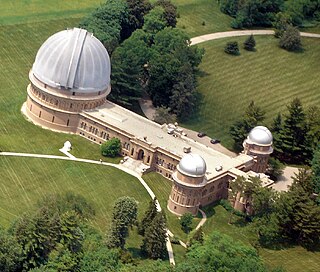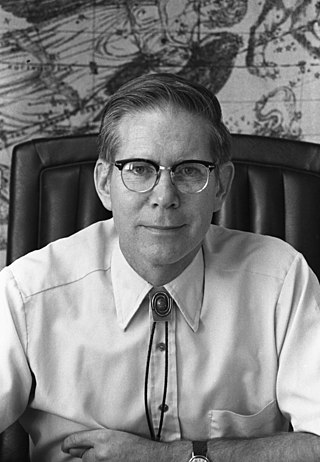
Yerkes Observatory is an astronomical observatory located in Williams Bay, Wisconsin, United States. The observatory was operated by the University of Chicago Department of Astronomy and Astrophysics from its founding in 1897 until 2018. Ownership was transferred to the non-profit Yerkes Future Foundation (YFF) in May 2020, which began millions of dollars of restoration and renovation of the historic building and grounds. Yerkes re-opened for public tours and programming in May 2022. The April 2024 issue of National Geographic magazine featured a story about the Observatory and ongoing work to restore it to relevance for astronomy, public science engagement and exploring big ideas through art, science, culture and landscape. The observatory offers tickets to programs and tours on its website.

The Southern African Large Telescope (SALT) is a 9.2-metre optical telescope designed mainly for spectroscopy. It consists of 91 hexagonal mirror segments each with a 1-metre inscribed diameter, resulting in a total hexagonal mirror of 11.1 by 9.8 m. However, its effective aperture is only 9.2 m. It is located close to the town of Sutherland in the semi-desert region of the Karoo, South Africa. It is a facility of the South African Astronomical Observatory, the national optical observatory of South Africa.

Otto Lyudvigovich Struve was a Ukrainian-American astronomer of Baltic German origin. Otto was the descendant of famous astronomers of the Struve family; he was the son of Ludwig Struve, grandson of Otto Wilhelm von Struve and great-grandson of Friedrich Georg Wilhelm von Struve. He was also the nephew of Karl Hermann Struve.

The Cerro Tololo Inter-American Observatory (CTIO) is an astronomical observatory located on the summit of Mt. Cerro Tololo in the Coquimbo Region of northern Chile, with additional facilities located on Mt. Cerro Pachón about 10 kilometres (6.2 mi) to the southeast. It is approximately 80 kilometres (50 mi) east of La Serena, where support facilities are located. The principal telescopes at CTIO are the 4 m Víctor M. Blanco Telescope, named after Puerto Rican astronomer Víctor Manuel Blanco, and the 4.1 m Southern Astrophysical Research Telescope, which is situated on Cerro Pachón. Other telescopes on Cerro Tololo include the 1.5 m, 1.3 m, 1.0 m, and 0.9 m telescopes operated by the SMARTS consortium. CTIO also hosts other research projects, such as PROMPT, WHAM, and LCOGTN, providing a platform for access to the southern hemisphere for U.S. and worldwide scientific research.

The Astronomical Society of the Pacific (ASP) is an American scientific and educational organization, founded in San Francisco on February 7, 1889, immediately following the solar eclipse of January 1, 1889. Its name derives from its origins on the Pacific Coast, but today it has members all over the country and the world. It has the legal status of a nonprofit organization.

The Hobby–Eberly Telescope (HET) is a 10-meter (30-foot) aperture telescope located at the McDonald Observatory in Davis Mountains, Texas.

The South African Astronomical Observatory (SAAO) is the national centre for optical and infrared astronomy in South Africa. It was established in 1972. The observatory is run by the National Research Foundation of South Africa. The facility's function is to conduct research in astronomy and astrophysics. The primary telescopes are located in Sutherland, which is 370 kilometres (230 mi) from Observatory, Cape Town, where the headquarters is located.

The Otto Struve Telescope was the first major telescope to be built at McDonald Observatory. Located in the Davis Mountains in West Texas, the Otto Struve Telescope was designed by Warner & Swasey Company and constructed between 1933 and 1939 by the Paterson-Leitch Company. Its 82-inch (2.1 m) mirror was the second largest in the world at the time. It was named after the Ukrainian-American astronomer of Baltic German origin Otto Struve in 1966, three years after his death; Struve had been the director of McDonald Observatory from 1932–1950.

Mount Lemmon Observatory (MLO), also known as the Mount Lemmon Infrared Observatory, is an astronomical observatory located on Mount Lemmon in the Santa Catalina Mountains approximately 28 kilometers (17 mi) northeast of Tucson, Arizona (US). The site in the Coronado National Forest is used with special permission from the U.S. Forest Service by the University of Arizona's Steward Observatory, and contains a number of independently managed telescopes.

The Harlan J. Smith Telescope is a 107-inch (2.7 m) telescope located at the McDonald Observatory, in Texas, in the United States. This telescope is one of several research telescopes that are part of the University of Texas at Austin observatory perched on Mount Locke in the Davis Mountains of west Texas. The telescope was completed in 1968 with substantial NASA assistance, and is named after Harlan James Smith, the first Texas director of McDonald Observatory. Smith was the Observatory Director for 26 years.

Harlan James Smith was an American astronomer. He served as director of the University of Texas McDonald Observatory from 1963 to 1989, where, among other accomplishments, he initiated the construction of the Harlan J. Smith Telescope, a 2.7-meter (107-inch) reflector bearing his name.

XO-1 (Moldoveanu) is a magnitude 11 G-type main-sequence star located approximately 530 light-years away in the constellation Corona Borealis. XO-1 has a mass and radius similar to the Sun. In 2006 the extrasolar planet XO-1b was discovered orbiting XO-1 by the transit method using the XO Telescope.

XO-1b is an extrasolar planet approximately 536 light-years away from Earth.
HD 155358 is a low metallicity yellow dwarf star approximately 43 pc away in the constellation Hercules. This star is known to be orbited by two extrasolar planets.
Robert M. Quimby is an American astronomer who received his Ph.D. in astronomy from the University of Texas at Austin. Prior to pursuing a career in astronomy, Robert Quimby was a member of the ska band 'Reel Big Fish', serving as a second trombonist. As a lead member of the Texas Supernova Search (TSS), Quimby and his team used the relatively small 18-inch ROTSE-IIIb robotic telescope on McDonald Observatory's Mount Fowlkes, along with a program he designed to track supernovae. In 2005, Quimby discovered SN 2005ap, at this writing the brightest explosion ever recorded. Quimby measured the burst at 100 billion times the luminosity of the Sun, at a distance of 4.7 billion light-years. As a comparison, this supernova occurred about 160 million years before the formation of the Earth. Quimby continues his research at the California Institute of Technology in Pasadena, California.
Steven Scott Vogt is an American astronomer of German descent whose main interest is the search for exoplanets.
The SFA Observatory (SFA) is an astronomical observatory located 17 km (11 mi) north of Nacogdoches, Texas (USA). The observatory is owned and operated by Stephen F. Austin State University (SFASU), and opened in 1976. It is used for undergraduate instruction and for graduate-level research.
Don E. Winget is an American astronomer and astrophysicist who studies white dwarf stars. He is the Harlan J. Smith Centennial Professor in Astronomy and a university distinguished teaching professor at the University of Texas at Austin.
Anita L. Cochran is an American astronomer, planetary scientist, and senior research scientist at the University of Texas at Austin. She is also the assistant director for research support at the McDonald Observatory. She focuses on the study of primitive bodies in the solar system and the composition of comets.
Caitlin M Casey is an observational astronomer and associate professor at the University of Texas at Austin. She is known for her work in extragalactic astrophysics; she works on the formation and evolution of massive galaxies in the early Universe.
























